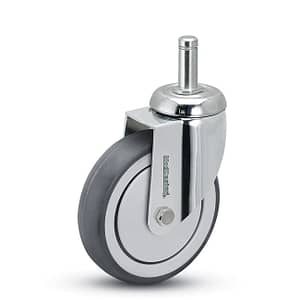Believe it or not, when it comes to casters there is a lot you need to know and understand. Specifically, you need to know how they are different and what you need to consider when selecting a caster for your business. If you need a refresher, check out our detailed caster overview.
Because casters are designed to make things move, the most critical part of a caster is the wheel. It is important to know the different types of wheel materials and the benefits of each type. When it comes to using casters, the tread and core can greatly impact the wheel’s overall performance.
When selecting a wheel, be sure to consider:
- Floor type and finish
- The wheel’s resistance to impact
- Rollability
- Chemical resistance
- Load capacity
- Noise level
Soft Tread Wheels
 Caster wheels with soft treads are great for providing a cushioned ride while also protecting delicate flooring surfaces. Since most are made of thermoplastic and mold-on rubber, they tend to be highly chemical, oil and acid-resistant. While a soft tread allows wheels to roll over small debris and is typically quieter than other materials, this also causes them to be a bit more difficult to roll and limits the overall load capacity of the caster.
Caster wheels with soft treads are great for providing a cushioned ride while also protecting delicate flooring surfaces. Since most are made of thermoplastic and mold-on rubber, they tend to be highly chemical, oil and acid-resistant. While a soft tread allows wheels to roll over small debris and is typically quieter than other materials, this also causes them to be a bit more difficult to roll and limits the overall load capacity of the caster.
Common soft tread caster wheels include thermoplastic rubber, rubber tread on iron core and polyurethane tread on plastic core. Popular applications for soft tread casters include medical and pharmaceutical equipment, food service equipment, processing plants and other light to medium loads.
Polyurethane Tread Wheels
 Polyurethane tread wheels offer easier rollability than soft tread wheels, while still providing excellent floor protection. Available in solid urethane, chemically or mechanically bonded to plastic, or chemically bonded to cast iron or aluminum cores, these wheels can have a capacity up to 3,000 pounds and have a high resistance to impact.
Polyurethane tread wheels offer easier rollability than soft tread wheels, while still providing excellent floor protection. Available in solid urethane, chemically or mechanically bonded to plastic, or chemically bonded to cast iron or aluminum cores, these wheels can have a capacity up to 3,000 pounds and have a high resistance to impact.
One disadvantage of poly wheels is that the tread can separate from the core if the wheel becomes overloaded, or if the tread suffers other damage that compromises its structure. One way to avoid these problems, however, is to use solid urethane wheels. Since the whole wheel is molded urethane and there is no core, the threat of tread separation and core corrosion is eliminated. Solid urethane wheels are also ideal for wash-down applications.
Overall, polyurethane wheels are extremely versatile and can be used in most standard applications.
Synthetic Tread Wheels
 Harder tread synthetic wheels offer a low resistance to rolling, and high impact strength and reliability. Synthetic wheels are available in solid elastomer, polypropylene/polyolefin, fiberglass reinforced polypropylene, phenolic and solid nylon.
Harder tread synthetic wheels offer a low resistance to rolling, and high impact strength and reliability. Synthetic wheels are available in solid elastomer, polypropylene/polyolefin, fiberglass reinforced polypropylene, phenolic and solid nylon.
While most synthetic wheels are excellent for high impact and abusive environments, the trade-off is that they tend to be louder than softer materials and are less forgiving when encountering debris. Additionally, some can not be exposed to wet environments, so it is extremely important to know where the wheels may be used when selecting a synthetic tread material.
Ferrous Wheels
 Due to their solid structure, ferrous wheels traditionally provide the highest load capacity, impact resistance, temperature range and rollability of any caster wheel available. True to their namesake, ferrous wheels are available in forged steel and cast iron, making them ideal for tough environments like warehouses and manufacturing plants where floor protection is not a high concern.
Due to their solid structure, ferrous wheels traditionally provide the highest load capacity, impact resistance, temperature range and rollability of any caster wheel available. True to their namesake, ferrous wheels are available in forged steel and cast iron, making them ideal for tough environments like warehouses and manufacturing plants where floor protection is not a high concern.
Ultimately, the wheel is what makes a caster a caster, so it’s critical to choose the right wheel for your environment and application. From impact and chemical resistance to rollability and capacity, there are many things you need to consider when choosing a wheel.
Do you have more questions about making the right choice for your application? Contact the experts at Conveyer & Caster – Equipment for Industry. We’ll work with you to find the best wheel to keep your business rolling!








